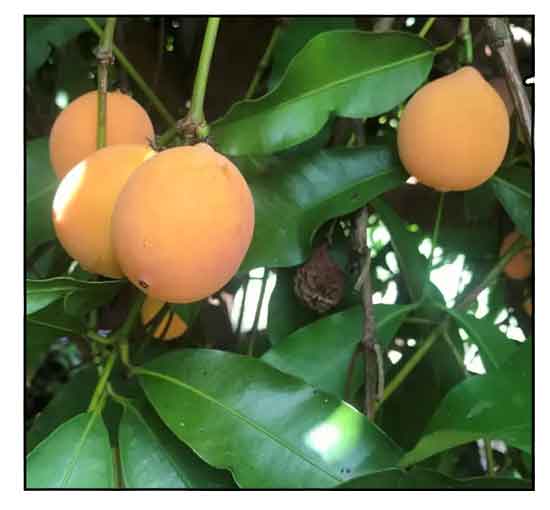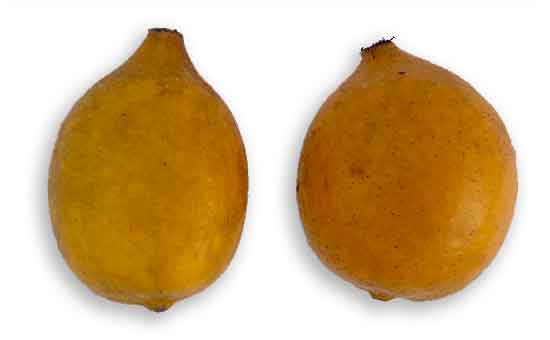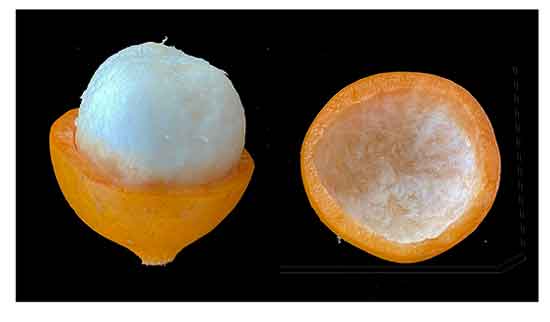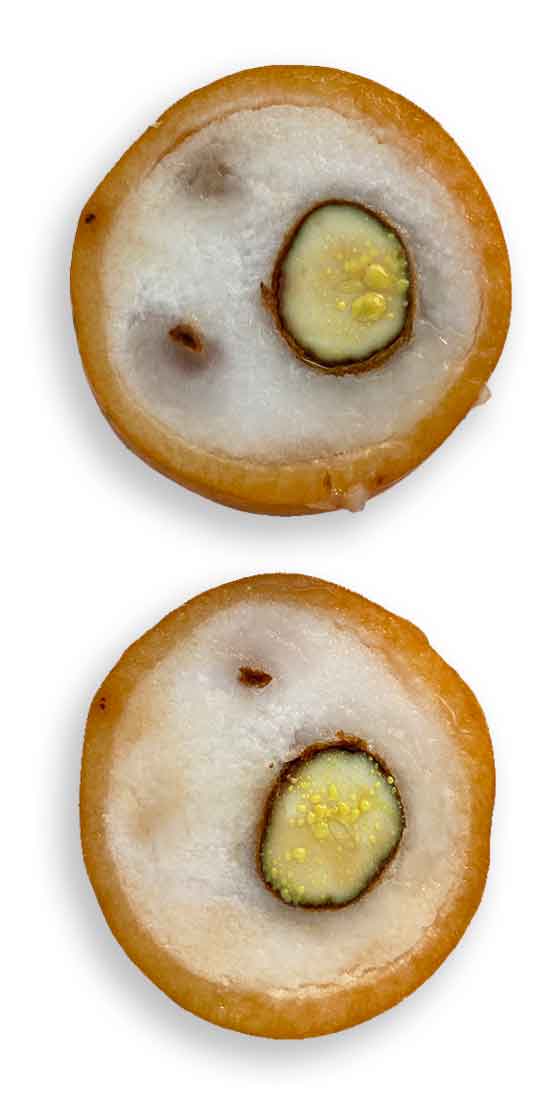 Gen info Gen info
- Garcinia is a genus of flowering plants in the family Clusiaceae. The number of species is disputed. Plants of the World Online recognizes up to 400 species. The plants in the genus are called saptrees, mangosteens, or garcinias.
- The genus Garcinia honors the French botanist Laurent Garcin (1683-1751). (2)
- Etymology: The word achachairu is a Guarani word meaning "honey kiss".
Botany
• Achacha is an evergreen shrub or small tree that grows about 6–10 m with pyramidal shaped canopy and stem of 40 cm diameter with a yellowish sap. The plant is found growing in sheltered aspects of woodland, often on limestone, at elevations of 150 – 900 meters and wet forests near the coast of Panama. The plant does best in moist, well drained, alluvial soils rich in organic matter. It is intolerant of saline soils and is moderately drought tolerant. Leaves are opposite, large, glossy dark-green, coriaceous, simple, and elliptic to lanceolate 15–28 cm long and 4–8 cm wide, with entire margin and acute to acuminate apex. Juvenile leaves are pinkish- bronze, turning yellowish-green then to dark green. Flower: Flowers are hermaphrodite, 4-5  white flowers occur on 2 cm long pedicels. Hermaphrodite flowers are 17–36 mm long with, 20–34 stamens, 2 sepals, 4 white, imbricate petals and an ovoid ovary. Male flowers are 9.5–12 mm long, with 26–28 stamens and a vestigial ovary. Fruit: Fertile flowers are followed by smooth ovoid to ellipsoid berry with hard thick skin. The fruit is similar in size and shape to an egg. It is up to 5.5–6 cm long and 4.4–5 cm across at the equatorial diameter and has an average weight of 50 grams. The fruits are bluish-green color when immature to a yellowish-orange and then changes to orange-reddish color as it ripens. Skin is firm and protective, yet quite easy to open. White interior flesh separates easily from the pericarp, containing 1-4 seeds. Seeds are brown, oval, polyembryonic, large 3.0–3.5 cm long and 1.5–2 cm wide surrounded in white acidic sweet pulp. Seeds exude yellow sap when cut. (14) white flowers occur on 2 cm long pedicels. Hermaphrodite flowers are 17–36 mm long with, 20–34 stamens, 2 sepals, 4 white, imbricate petals and an ovoid ovary. Male flowers are 9.5–12 mm long, with 26–28 stamens and a vestigial ovary. Fruit: Fertile flowers are followed by smooth ovoid to ellipsoid berry with hard thick skin. The fruit is similar in size and shape to an egg. It is up to 5.5–6 cm long and 4.4–5 cm across at the equatorial diameter and has an average weight of 50 grams. The fruits are bluish-green color when immature to a yellowish-orange and then changes to orange-reddish color as it ripens. Skin is firm and protective, yet quite easy to open. White interior flesh separates easily from the pericarp, containing 1-4 seeds. Seeds are brown, oval, polyembryonic, large 3.0–3.5 cm long and 1.5–2 cm wide surrounded in white acidic sweet pulp. Seeds exude yellow sap when cut. (14)
Distribution
- Introduced.
- Cultivated.
- Native to Guyana, Haiti, Jamaica, Leeward Is., Trinidad-Tobago, Windward Is. (1)
- Grown primarily in wet tropical biome.
 Constituents Constituents
- Study of branches isolated xanthones 7-preniljacareubin (PJB), 1,3,5,6-tetrahydroxy xanthone (THX), 3-demethyl-2-geranyl-4-prenylbellidy-pholine (DGP) and 1,5,8-trihydroxy-4′, 5′-dimethyl-2H-pyrane (2,3:3,2)-4-(3-methylbut-2-enyl) xanthone (TDP). (see study below) (5)
- Spectroscopic study of methanol extract
identified 3-Demethyl-2-geranyl-4-prenylbellidypholine (1) and 1,5,8-trihydroxy-4′,5′-dimethyl-2H-pyrane (2,3:3,2)-4-(3-methylbut-2-enyl) xanthone (2), gartanin (3) and stigmasterol (4) were identified on the basis of spectroscopic techniques. (see study below) (8)
- LC-Orbitrap MS/MS analysis of peels identified polyphenolic compounds including epicatechin, procyanidins, mangostanol, and gamma-mangostin. (see study below) (10)
- LXR-SPA binding assay and bioassay-guided fractionation of bark and stem extracts isolated a new polyisoprenylated benzophenone, guttiferone I (1). (13)
- Study evaluated phenolic compounds, antioxidant potential, and mineral profile of peel, pulp, and seed of achachairu fruit.
Moisture content was high in the fruit peel (79.63%) and pulp (80.68%). Potassium was the most abundant mineral in fruit seed (224.56 mg/100g), followed by peel (146.32 mg/100g) and pulp (46.32 mg/100g). Least abundant element was copper (peel 0.03, pulp 0.01, and seed 0.04 mg/100g). Phenolic compounds were highest in the peel aqueous extract (149.71 mf EAG/100g), and ethereal extract from seed (212.28 mg EAG/100g). Tannin content was highest in seeds, both for condensates (63.83 mg CAE/g) and hydrolysates (11.84 mg GA/g). (18)
Properties
- Studies have suggest cardioprotective, gastroprotective, antioxidative, antiproliferative, diuretic, antiurolithic, anti-melanoma, cytotoxicity, genotoxicity, anti-Leishmanial properties.
 Parts used Parts used
Fruit, peel, juice.
Uses
Edibility
- Fruits are edible with a sweet and tangy flavor. Pulp has a flavor resembling mangosteen.
- Fruit eaten raw; used in juices, pastries, jams and jellies, ice creams and sorbets.
- Rind can be used for making a drink by blending and overnight infusion in water.
- Peel used in preparing of tea infusions.
Folkloric
- No reported folkloric medicinal use in the Philippines.
- Traditionally used as a hunger suppressant and for healing of skin problems..
- Used for treatment of rheumatism, inflammation, pain, gastric disorders.
- The juice of peel used for skin nourishing properties.
Others
- Resin: Tree yields a hard wax. A waxy resin exudes from nodes on the branches, which emits a pleasant aroma and is used as torch fuel. (19)
- Wood: Reddish wood used for common joinery.
- Cosmetics: Dried and powdered gum resin from the fruit, peel, and seed used as ingredient in commercial cosmetic preparations like hair and skin conditioner and masking agent. (19)
Studies
• Cardioprotective / Rind and Pulp: Study evaluated the phytochemicals in achacha rind and pulp and its potential for treatment of symptoms of metabolic syndrome in male Wistar rats fed with high-carbohydrate, high fat, or corn starch diets. Rats fed a high-carb or high fat diet exhibited hypertension, dyslipidemia, central obesity, impaired glucose tolerance, and non-alcoholic fatty liver disease. G. humilis was used as rind powder or 2% pulp. G. humilis rind decreased systolic blood pressure, diastolic stiffness, left ventricular inflammatory cell infiltration, and collagen deposition in the high-carb and high-fat diet fed rats. There was no change in glucose tolerance, body weight, or body composition. Results suggest the rind, not the pulp, offers potential cardioprotection with minimal metabolic changes in the model of diet-induced metabolic syndrome. (4)
• Gastroprotectice Xanthones / Antioxidative / Branches: Study evaluated the gastroprotective effect of xanthones 7-preniljacareubin (PJB), 1,3,5,6-tetrahydroxy xanthone (THX), 3-demethyl-2-geranyl-4-prenylbellidy-pholine (DGP) and 1,5,8-trihydroxy-4′, 5′-dimethyl-2H-pyrane (2,3:3,2)-4-(3-methylbut-2-enyl) xanthone (TDP) isolated from the branches of G. achachairu. The xanthones were tested against ethanol 60%/HCl 0.3N-induced gastric ulcer in female Swiss mice. Xanthones PJB, THX, DGP, and TDP exhibited gastroprotective effect after intraperitoneal treatment. Only PJB and THX exhibited anti-ulcer effect after oral administration. Both PJB and THX augmented antioxidant capacity and prevented an increase in myeloperoxidase activity and TNF level. Only THX showed invitro free radical scavenging activity; only PJB prevented mucus depletion on gastric mucosa. PJB and THX inhibited invitro H+K+-ATPase activity at a range similar to omeprazole. Results suggest anti-ulcer efficacy of xanthones. (5)
• Gastroprotectice / Guttiferone A / Seeds: Study evaluated the gastroprotective properties of seed, leaf, and branch methanolic extracts and guttiferone A from Garcinia achachairu in pylorus-ligated mice models. Extracts at 500 mg/kg intraduodenally administered significantly reduced the ulcerative lesions in the ethanol/HCl-model. The seed extract in doses of 50, 250, and 500 mg/kg was most active with a dose dependent effect and percentage inhibition of gastric lesions of 41, 49, and 85% respectively. Seed extract also reduced ulcer lesions in indomethacin/bethanechol-induced ulcer, with percentage inhibition of 24, 58, and 90% respectively. There was reduction of gastric juice volume, total acidity, and an increase in gastric pH. Silica gel column chromatography isolated guttiferone A. Results suggest that G. achachairu extracts and guttiferone A produced gastroprotective effects. (6)
• Anti-Leishmanial / Seeds: Study evaluated extracts, fractions, and isolated compounds from selected Brazilian medicinal plants against strains of promastigotes of Leishmania amazonensis and L. brasiliensis in vitro. The methanolic extracts of seeds of G. achachairu and guttiferone A presented IC50s of 35.9 and 10.4 µg/mL against L. amazonensis, respectively. (7)
• Antiproliferative Xanthones / Branches: Study evaluated the chemical profile and antiproliferative effects of methanol extract, fractions, and two xanthones, against some human tumor cell lines viz. U-251 (glioma), MCF-7 (breast), NCI/ADR-RES (ovary expressing multi-drug resistance phenotype), 786-0 (kidney), NCI-H460 (lung, non-small cells), PC-3 (prostate) and HT-29 (colon), non-tumor cell line HaCat (human keratinocytes) in doses of 0.25–250 μg mL − 1 for 48 h. Compounds 1 and 2 exhibited cytocidal activity, especially against breast, prostate, and kidney cell lines, with TGI values of 15.8, 4.9, 9.1, and 39.4, 44.7, and 40.9 µg/mL, respectively. Data showed G. achachairu has potent antiproliferative action and a potential source of anticancer compounds. (8)
• Diuretic / Antiurolithic / Leaves: Study evaluated the diuretic and antiurolithic effect of methanol extract (ME), dichloromethane (DCM), and ethyl acetate (EA) fractions of G. humilis leaves. The extracts and fractions promoted 8h diuresis in rats. The ME at 30 mg/kg increased urinary Na+, K+, and Cl- excretion. DCM and EtA fractions increased K+ and Cl- excretion, without change in Na+ elimination. All preparations exerted an antiurolithic effect in vitro, decreasing the number of calcium oxalate crystals of monohydrate and dihydrate types. Results preparations of leaves present promising strategies to induced diuresis and antiurolithic effects. (9)
• Anti-Melanoma / Functional Food Potential / Fruit Peel Waste: Industrial processing of the fruit generates the peel waste. Study evaluated the upcycling of the peel for antimelanoma activity. The phenolics and flavonoids extraction and anticancer activity was highest when extracted at 37°C. LC-Orbitrap MS/MS analysis identified polyphenolic compounds including epicatechin, procyanidins, mangostanol, and gamma-mangostin. The extracts showed dose-dependent anti-melanoma activity on MM418C1 (BRAF mutated oncogene) and D24 (wild type BRAF oncogene) cells with IC50 range of 130-200 µg/mL and 122-176 µg/mL. Minimal effect on control fibroblast cells suggest selective activity on cancer cells, and morphological changes suggest apoptosis. Although extracts were 10-fold less effective than anticancer drugs controls, cisplatin and vemurafenib, the moderate anticancer activity of Garcinia peel provides opportunities for upcycling the discarded waste as functional food ingredient. (10)
• In Vitro Cytotoxicity and Genotoxicity / Human Breast MCF-7 Cells: Study evaluated the cytotoxicity and genotoxicity of G. humilis crude extract in breast tumor cells. The crude extract was cytotoxic only at high concentrations (IC50 5.084 mg/mL). Extract did not induce genotoxicity at 1 and 5 mg/ml but showed signs of DNA fragmentation and DNA fragmentation at 10 mg/mL. Cytotoxic activity against breast adenocarcinoma cells at high concentrations advise use with caution and further studies for therapeutic and toxicological potential in humans. (11)
• Anti-Inflammatory / Leaves: Study evaluated the in vivo and in vitro effects of methanol extracts of G. humilis leaves on inflammatory cells behavior (migration and chemical mediators release) and hypersensitivity using carrageenan-induced inflammation in subcutaneous tissue of male Swiss mice. Anti-inflammatory activity of isolated compounds viz. friedelin (1), canophyllol (2), amentoflavone (3), and 3-desmethyl-2-geranyl-4-prenylbellidypholine xanthone (4) (10 µM) was evaluated in macrophages nitric oxide (NO) and TNF release. The ME given orally significantly reduced neutrophil migration and decreased TNF, IL-1ß, and CXCL1 levels, without interfering with protein exudation and IL-6. In vitro, the ME reduced IL-1ß and IL-6 levels. The ME also reduced expression of CD62L and CD18 and neutrophil chemotaxis. Compounds 1, 3, and 4 decreased secretion of NO and TNG by RAW264.7. The ME extract effects were extended to pain-like behavior induced by carrageenan in mice hindpaw. The ME inflammatory effects were attributed to activity on neutrophil migration and on chemical mediator release. (12)
• Ultrasonic Treatment Effect on Starch from Achachairu / Seeds: Study evaluated the effect of ultrasound high-intensity low-frequency on extraction and modification of starch characteristics from achachairu seeds. Ultrasonic treatment was applied to seeds and starch at 300W at different exposure times. Results showed ultrasound assisted extraction achieved higher yield (42.05%) and higher starch content (74.94 g/100g). Exposure time of 60 min yielded greater stability in water absorption, oil, and syneresis index (during storage) and is considered a thickening and emulsifying agent. Ultrasonic treatment can modify seed starch properties, making it a promising technology for starch extraction and modification. (15)
• Effect on Supplementation of Yogurt with Achachairu Pulp: Yogurt is a product obtained by fermentation of milk. Study evaluated the physiochemical and textural properties of a yoghurt supplemented with 0, 5, 10, 15, and 20% Achachairu pulp. Achachairu pulp presented high moisture content, water activity, acidity, lipids, and vitamin C in formulations with higher pulp percentage. The formulations proposed with addition of different pulp concentrations improved the physiochemical and texture attributes of yogurt. (16)
Availability
- Wild-crafted.
- Seeds in the cybermarket.
|

![]()




 white flowers occur on 2 cm long pedicels. Hermaphrodite flowers are 17–36 mm long with, 20–34 stamens, 2 sepals, 4 white, imbricate petals and an ovoid ovary. Male flowers are 9.5–12 mm long, with 26–28 stamens and a vestigial ovary. Fruit: Fertile flowers are followed by smooth ovoid to ellipsoid berry with hard thick skin. The fruit is similar in size and shape to an egg. It is up to 5.5–6 cm long and 4.4–5 cm across at the equatorial diameter and has an average weight of 50 grams. The fruits are bluish-green color when immature to a yellowish-orange and then changes to orange-reddish color as it ripens. Skin is firm and protective, yet quite easy to open. White interior flesh separates easily from the pericarp, containing 1-4 seeds. Seeds are brown, oval, polyembryonic, large 3.0–3.5 cm long and 1.5–2 cm wide surrounded in white acidic sweet pulp. Seeds exude yellow sap when cut. (
white flowers occur on 2 cm long pedicels. Hermaphrodite flowers are 17–36 mm long with, 20–34 stamens, 2 sepals, 4 white, imbricate petals and an ovoid ovary. Male flowers are 9.5–12 mm long, with 26–28 stamens and a vestigial ovary. Fruit: Fertile flowers are followed by smooth ovoid to ellipsoid berry with hard thick skin. The fruit is similar in size and shape to an egg. It is up to 5.5–6 cm long and 4.4–5 cm across at the equatorial diameter and has an average weight of 50 grams. The fruits are bluish-green color when immature to a yellowish-orange and then changes to orange-reddish color as it ripens. Skin is firm and protective, yet quite easy to open. White interior flesh separates easily from the pericarp, containing 1-4 seeds. Seeds are brown, oval, polyembryonic, large 3.0–3.5 cm long and 1.5–2 cm wide surrounded in white acidic sweet pulp. Seeds exude yellow sap when cut. ( Constituents
Constituents Parts used
Parts used